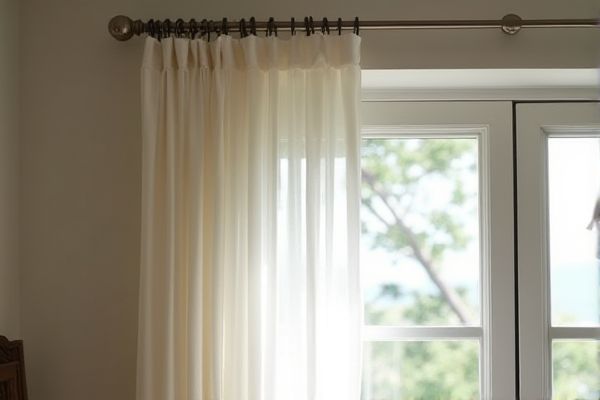
Choosing between a fixed rod and a retractable rod depends on your space and functionality needs, as fixed rods offer sturdy, permanent support while retractable rods provide flexibility and easy storage. Explore the advantages and drawbacks of both options to determine which rod best suits your home setup in the full article below.
Table of Comparison
| Feature | Fixed Rod | Retractable Rod |
|---|---|---|
| Length | Fixed length, typically set size | Adjustable length, customizable fit |
| Installation | Requires precise measurement and mounting | Simple, often tension-mounted without tools |
| Portability | Non-collapsible, bulky for transport | Compact when retracted, easy to store |
| Durability | Sturdy, fewer moving parts | More moving parts, potential wear over time |
| Use Case | Permanent fixtures, heavy-duty support | Temporary setups, adjustable needs |
| Price | Generally lower cost | Usually higher cost due to mechanism |
Fixed Rod vs Retractable Rod: Key Differences
Fixed rods provide constant length and robust stability, ideal for permanent installations like closets or curtain rails. Retractable rods offer adjustable length and enhanced flexibility, making them suitable for varied spaces and easy storage. Understanding these differences helps in choosing between fixed support strength and versatile sizing.
Durability Comparison: Fixed and Retractable Rods
Fixed rods typically offer greater durability due to their solid, one-piece construction, which reduces the risk of mechanical failure and wear over time. Retractable rods feature multiple segments and moving parts that can be prone to loosening, corrosion, or breakage with frequent use. High-quality materials like stainless steel or reinforced aluminum enhance the lifespan of both types, but fixed rods generally maintain structural integrity longer under heavy or continuous usage.
Installation Process: Which is Simpler?
Fixed rods feature straightforward installation with minimal components, often requiring just mounting brackets and screws, making the process quicker and easier for most users. Retractable rods involve more complex mechanisms, including tension springs or locking systems, necessitating precise adjustments and sometimes professional assistance. The simplicity of fixed rod installation generally makes it the preferred choice for quick, hassle-free setup.
Space and Aesthetic Considerations
Fixed rods save space by offering a compact, permanently installed solution that reduces clutter and maintains a clean, streamlined look in small rooms or narrow spaces. Retractable rods enhance aesthetic versatility by allowing users to extend or hide the rod as needed, creating a minimalist appearance when retracted and providing flexible functionality for varying curtain sizes. Homeowners prefer fixed rods for a consistent design, while retractable rods appeal for adaptable aesthetics and space efficiency in multifunctional areas.
Cost Analysis: Fixed vs Retractable Rods
Fixed rods generally offer a lower initial cost compared to retractable rods, making them a budget-friendly option for basic installations. Retractable rods, while more expensive upfront, provide added versatility and durability, potentially reducing long-term replacement or maintenance expenses. Your choice depends on balancing immediate affordability with future savings and functional benefits.
Maintenance and Longevity
Fixed rods require minimal maintenance due to their sturdy, simple design, with fewer moving parts reducing the risk of mechanical failure over time. Retractable rods, while offering versatility and space-saving benefits, demand regular lubrication and cleaning to ensure smooth operation and prevent wear on sliding mechanisms. Durable materials such as stainless steel or aluminum enhance the longevity of both rod types, but fixed rods generally offer a longer lifespan with less upkeep.
Flexibility and Versatility in Use
Retractable rods offer superior flexibility by allowing length adjustments to accommodate various spaces and purposes, making them ideal for evolving needs. Fixed rods provide consistent stability and strength but lack adaptability when your setup changes or requires different dimensions. Choosing a retractable rod enhances your versatility, adapting effortlessly to different room sizes and uses.
Ideal Applications for Each Rod Type
Fixed rods are ideal for permanent installations such as shower curtains or closet rods where stability and consistent support are crucial. Retractable rods offer versatile applications, perfect for spaces where flexibility and temporary use are needed, like expanding window curtains or adjustable room dividers. Your choice depends on whether you prioritize durability with a fixed setup or adaptability with a retractable design.
Pros and Cons: Fixed Rods
Fixed rods offer superior strength and stability due to their solid construction, making them ideal for heavy-duty applications and consistent use. They require minimal maintenance and provide a reliable, long-lasting solution without the risk of mechanical failure associated with moving parts. However, fixed rods lack flexibility and compactness, limiting adjustability and ease of storage compared to retractable rods.
Pros and Cons: Retractable Rods
Retractable rods offer versatility and space-saving benefits, making them ideal for smaller areas where adjustable length is crucial. However, their mechanisms can be prone to wear and require occasional maintenance compared to the durability of fixed rods. You should consider that retractable rods may have limited weight capacity, which can affect the type of curtains or items you hang.
 homyna.com
homyna.com